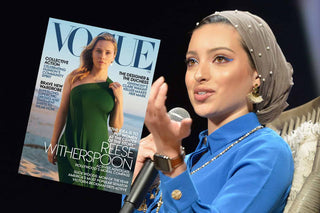Last week, journalist, activist, writer, entrepreneur, and podcast director, Noor Tagouri posted an Instagram video where she's seen bouncing up and down with excitement and disbelief as she holds the February edition of Vogue in her arms. She squeals and basks in the euphoria that comes with being featured in such a magazine. Upon flicking to the full page spread that features Noor, "That's so cool!!!" turns quickly to dismay and devastation as her eyes catch the misprinting of her name as "Noor Bukhari" -- a Pakistani actress who also wears the hijab.
[embed]https://www.instagram.com/p/BsvNDpxBEbZ/[/embed]
Vogue was quick to release an apology online stating,
"In the February issue of Vogue the writer and activist Noor Tagouri (@noor) was misidentified in a caption as “actor, director, and model Noor Bukhari.” We are sincerely sorry for the mistake. We were thrilled at the chance to photograph Tagouri and shine a light on the important work she does, and to have misidentified her is a painful misstep. We also understand that there is a larger issue of misidentification in media—especially among nonwhite subjects. We will try to be more thoughtful and careful in our work going forward, and we apologize for any embarrassment this has caused Tagouri and Bukhari." The misprint will however, remain on stands, in print, forever.
Many have criticized Vogue for their pseudo apology and questioned their intent and called their "non-apology" insulting to not only Tagouri, but to the vast majority of their readership. One thing in particular that was highly problematic about Vogue's swift apology was their usage of "nonwhite subjects" as an example in their statement on misidentification in the media. By extension, Vogue has made it clear that they see "whites" as the majority, "nonwhite subjects" being the demographic that is inferior to white people. Why is there even a distinction that has to be made?
This is not the first time Noor has been misidentified by the media. In January of 2017, RawStory misidentified Noor as the wife of Omar Mateen (the pulse nightclub shooter), Noor Salman. This misstep placed Noor in great danger at the time when investigations were ongoing and emotions were running high. It was a profound example of lazy and ignorant journalism.
[embed]https://twitter.com/ntagouri/status/821092803023437824?lang=en[/embed]
What's becoming more and more apparent through this disturbing trend is the cognitive dissonance that plagues America today; a woman who wears the headscarf is no different from the next. We are all the same. This is highly problematic and dangerous. In the hyper-Islamophobic world we live in, Americans are becoming more and more robust in their "us vs. them" propaganda. Writer Rafia Zakaria writes about this phenomenon in her recent post on
CNN.
"In the skin-deep tolerance of contemporary American visual culture, the headscarf-clad woman is the ultimate stock image, devoid of specificity and individuality and yet saddled with all the preconceived ideas the onlooker has ever had about Muslims. If encountered in real life, she can be stared at or harassed, or cornered into answering question after question about her faith and herself, or asked to provide validation for both. If encountered on the page of a fashion magazine, she can be flipped past, her presence understood as the perfunctory salute to the surface commitment to diversity that fashion magazines sometimes flash at their readers."
Misrepresentation, tokenism, racism and cultural appropriation plague the fashion industry. Vogue's error was careless -- they were too lazy to do their research. Forget research, they lacked the basic common courtesy of knowing exactly who you are working so intimately with. That regard was just not there and it begs the question, why? Why did Vogue make such a basic mistake? They misidentified a woman who is already part of a subgroup who are harassed and treated as "other" in American society. Was this error just a nod to the psychological states of most Americans today? Where they feel there are no moral or social consequences if they misidentify a visible minority. This is dangerous and problematic. This can't be written off as a one-time mistake if it highlights an underlying cancer that is growing more and more malignant as the days ensue. This mistake is part of a bigger problem, and it emphasizes a much more serious deterioration at the cultural level.
Noor then went on to post a series of photos from a spread she also did with Vogue Arabia:
"MOOD - as we shatter through every stereotype, pre-conceived notion, lack of deep understanding and representation. No more “filling diversity quotas” or “tokenism.” We are here, we’ve been here, our stories are here - and we will tell them, the right way. @VogueArabia"
[embed]https://www.instagram.com/p/Bsx3ShmBzYX/[/embed]
Vogue apologizing is not the take-away here. The issue is still at hand and requires us to grapple with the reality of the culture we are engulfed in on a deeper level. We must question those who are feeding us information. Question their intent, their vision, their inclusion and lack thereof. It's vital that media outlets are held accountable for their missteps on a significant scale. This culture of misidentifying Muslim, hijab clad women is dangerous and toxic. These media moguls may not ever have to face the consequences of what that means, to be wrongly identified in a world that deems you a threat to national security, but they ought to be held accountable for their subtle belligerency. And that means beyond issuing an apology online. Actions do indeed, speak far louder than words. Vogue can and must do better.


